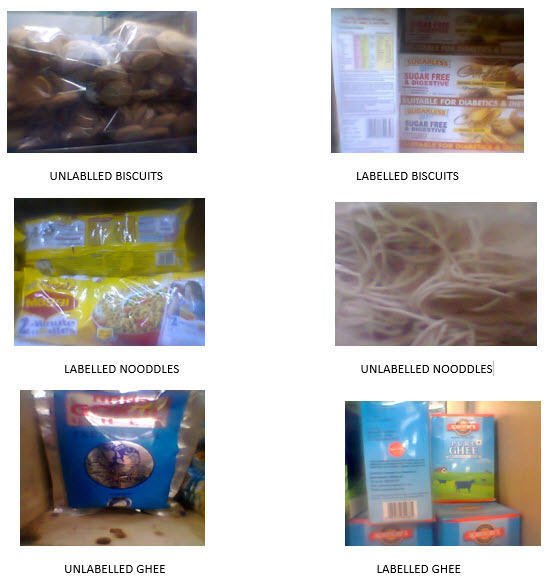Present study was to know the how much knowledge about the nutritional labelled foods. samples were selected and collected general information like their age, awareness of labelled foods available in the market, their level of education with the help of pretested questionnaire.
In this present study all the information taken from the people and recorded. From the total samples 22.5% of people having the awareness labelled food products and remaining 77.5% don’t have any awareness on labelled food items. Most of the people don’t have any knowledge on nutritional labelled foods.
In the super markets 87% of the label food is available. In that labelled foods some of the misleading labels and Un-label foods items are also available. in super markets Un-label foods items like pap-ads, dhal, noodles, some snack items etc. These products are commonly un-labelled, because they are comes from the small scale industries.
In the super markets nutritional labelled and unlabeled food products are available. food products like cereals(21%), pulses(15%), Ata’s(8%), noodles(5%), sugars and jag-gay(2%), spices mixes(5%), dry fruits and nuts(6%), juices(7%), bakery items(29%), coffee and tea(2%), snakes(18%), milk and milk products(9%), salts(1%), chocolates and confectioneries(2%), health drinks(21%), biscuits(11%), chips(4%), ice-creams(6%), honey(1%), and instant powders(4%) are available.
From the above study can be concluded that the only 22.5% of the people having knowledge about the nutritional labelled food products.
From the frequency charts seems to be improve the awareness levels on the people. Foods are play the major role for the good health. So we should be create some awareness about the nutritional labelled food products in the community.
INTRODUCTION:
Nutrition labeling refers to the standardized presentation of the food. The food label is one of the most important and direct means of communicating product information between buyers and sellers. Food labels are to provide consumers with information about the environmental, technical, and socioeconomic conditions under which the products were produced, as well as the health and safety aspects of food products. The information about nutrition labelling and health benefits of the food is one of the important factors that influence decision making. The modern package label has taken the responsibility for educating the consumer about the product by multitasking such as, attracting, promoting and motivating at the point of purchase through the information on the label. The labels were closely observed for nutrient contents declaration on calories, fat, protein dietary fiber, vitamins and mineral content either as percentage daily value or recommended dietary intake (RDI), or per 100gms or 100 ml or per serving size.
In India, the idea of bringing out specific laws for nutrition labelling is under active consideration. As of now, it is not mandatory for processed foods in general, except for rules 32A, 37B, and 37D of the prevention of food adulteration act .Rule 37A states that a food claimed to be enriched with nutrient shall give the quantities on the labels. Rule 37D refers to health claim benefits of the oils.
Guiding Principles of Nutrition Labelling; To make nutrition labelling useful, available and accessible to consumers. At the same time, they should be clear, simple, accurate, practical, readable, informative, consistent and legible.
Codex Guidelines; Codex commission adopted international guidelines on nutrition labelling in 1985.the use of nutrition labelling is voluntary except when a nutrition claim is made. The codex core list includes energy, protein, fat, and carbohydrate content. In addition, a country may require the declaration of nutrients in the interest of the health of its population.Nutrient labelling provides a means for conveying information on the nutrient content of a food .
As per the Indian regulations, every pre packed food shell carry label. Besides providing the basic information about the food like name of the food and ingredients.. Nutritional information or nutritional facts per 100g or 100ml or per serving shall be given on the label, which should contain
1. Energy value in Kcal,
2. Amount of protein, carbohydrate (specify the quantity of sugar) and fats in grams.
3. Amount of any other nutrient for which a nutrition or health claim is made.
4. Amount of Trans fatty acid.
A label serves three primary functions:
It provides basic product information
It provides health, safety, and nutrition information.
It acts as a vehicle for food marketing, promotion and advertising
NUTRIENT PROFILE:
People look at food labels for different reasons. But whatever the reason, many consumers would like to know how to use this information more effectively and easily. The following label-building skills are intended to make it easier for you to use nutrition labels to make quick, informed food choices that contribute to a healthy diet.
Specific label formats;
Bilingual format
Verity packets/ aggregate formats
Simplified formats
As packaged/as prepared/dual Colum formats
Tran’s fat labelling formats

Bilingual Format: When nutrition labelling must be presented in a second language, the nutrition information may be presented in separate nutrition labels for each language or in one label with the second language, translating all required information, following that in English.
Variety Packs/Aggregate Format: When a package contains two or more packaged foods that are intended to be eaten individually, such as a variety pack of breakfast cereals or when packages may be used interchangeably for the same type of food.
Simplified Format: A simplified Nutrition Facts label may be used if at least eight of the following nutrients are present in insignificant amounts: Calories, total fat, saturated fat, trans fat, cholesterol, sodium, total carbohydrate, dietary fibre, sugars, protein, vitamin A, vitamin C, calcium and iron.
As Packaged/As Prepared/Dual Column Format: “As prepared” refers to the product after it has been made ready for consumption (e.g., ingredients added per instructions and cooked such as a cake mix that has been prepared and baked or a condensed or dry soup that has been reconstituted).
Trans Fat Labelling: FDA is requiring that trans fatty acids be listed in nutrition labelling in response to a petition from the Centre for Science in the Public Interest and to published human studies that show that intake of trans fatty acids, similar to the intake of saturated fatty acids, increases low density lipoprotein-cholesterol (LDLC) (“bad cholesterol”) in the blood.
CONSUMER INFORMATION:
Reading a nutritional label: A typical label should have information of various nutrients present as expressed an amount per serving or per 100g.in order to read and understand the nutrition facts on the food label.Serving size; at the very top of all food labels for example serving size; 2 pieces(100g)
Calories, Calories from fat, Total fat, Saturated fat, Trans fat, Polyunsaturated fat (PUFA) and monounsaturated fat (MUFA), Cholesterol, Sodium, Total carbohydrate, Dietary fiber, Sugars, Protein, Daily value.
Labelling previsions in existing food laws:
- Prevention of food adulteration act, 1954: under rule 32, it has been specified that every package of food shall carry a label and unless otherwise provided in these rules every label should carry.
- The name, trade name or description of food contained in the package.
- The name of ingredients used in the product in descending order of their composition by weight or by volume as the case may be.
- In case both colour and flavours are used in the product, the label should mention.
- If gelatine is used as an ingredient, a declaration should be made using the words “gelatine is animal origin”.
- A label should not contain any statement, claim, design, device, fancy name or abbreviation which is false or misleading in any particular way, concerning the food contained in the package or concerning the quality or the nutritive value or in relation to the place or origin of the food.
- Labelling of pre-packed irradiated foods should be in accordance with the provisions of rule 32 and 42 of PFA Act.
- The package, label or advertisements of edible oils and fats should not use expressions like super-refined, extra-refined, micro-refined, double-refined, ultra-refined, anti-cholesterol, soothing to heart or saturated and fat free.
- PFA act also makes it mandatory that label should not use words implying recommendations by medical profession.
- Name of the product, date of manufacture, net weight/volume, name and address of the manufacturer.
- Unauthorised use of words, pictures etc..Showing imitation is prohibited.
- Every package which contain monosodium glutamate shall bear the label saying “this package contain monosodium glutamate. Unfit for infant below 12months ”
- List of any permitted preservatives and additives added.
- Licence number and category.
- List of poisonous metals such as lead, copper, arsenic, pesticides, sequestering and buffering agents. It has to be ensured that no meat product shall contain MSG in excess of percent by weight.
FOOD LAWS AND REGULATION:
Food Safety and Standards Act
The Indian Parliament has recently passed the Food Safety and Standards Act, 2006that overrides all other food related laws. It will specifically repeal eight laws:
The Prevention of Food Adulteration Act, 1954
- The Fruit Products Order, 1955
- The Meat Food Products Order, 1973
- The Vegetable Oil Products (Control) Order, 1947
- The Edible Oils Packaging (Regulation) Order, 1998
- The Solvent Extracted Oil, De oiled Meal, and Edible Flour (Control) Order, 1967
- The Milk and Milk Products Order, 1992
- Essential Commodities Act, 1955 relating to food
Voluntary Standards; There are two organizations that deal with voluntary standardization and certification systems in the food sector. The Bureau of Indian Standards (BIS) looks after standardization of processed foods and standardization of raw agricultural produce is under the purview of the Directorate of Marketing and Inspection (DMI).
Bureau of Indian Standards (BIS)
BIS has standards for most of processed foods. In general, these standards cover raw materials permitted and their quality parameters; hygienic conditions under which products are manufactured and packaging and labelling requirements. Manufacturers complying with standards laid down by the BIS can obtain and "ISI" mark that can be exhibited on product packages. BIS has identified certain items like food colours/additives, vanaspati, and containers for packing, milk powder and condensed milk, for compulsory certification.
Directorate of Marketing and Inspection (DMI)
The DMI enforces the Agricultural Products (Grading and Marketing) Act, 1937. Under this Act, Grade Standards are prescribed for agricultural and allied commodities. These are known as "Agmark" Standards. Grading under the provisions of this Act is voluntary. Manufacturers who comply with standard laid down by DMI are allowed to use "Agmark" labels on their products.
LABELLED AND UNLABELLED FOOD PRODUCTS AVAILABLE IN THE SUPER MARKET

About Author:
B.Sirisha
Msc Food Nutrition and Dietetics
Andhra university, Andhra Pradesh
siri4747@gmail.com
NOW YOU CAN ALSO PUBLISH YOUR ARTICLE ONLINE.
SUBMIT YOUR ARTICLE/PROJECT AT articles@pharmatutor.org
Subscribe to Pharmatutor Alerts by Email
FIND OUT MORE ARTICLES AT OUR DATABASE









